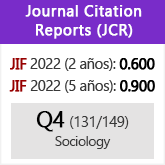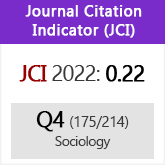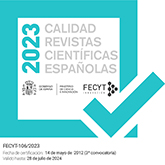Tarjetas de respuesta ¿Son necesarias para una correcta cumplimentación del cuestionario?
DOI:
https://doi.org/10.3989/ris.2012.12.05Palabras clave:
Calidad de la respuesta, Encuesta presencial, Efectos producidos por el orden de las respuestas, Entrevistadores, No Respuesta parcial, Preguntas de tarjetaResumen
La utilización en encuestas de preguntas con “tarjetas de respuesta” está totalmente aceptada por la comunidad investigadora. Esto supone una carga de trabajo “extra” en la tarea del entrevistador, lo que explica que en ocasiones no se utilicen correctamente. Pese a esta situación, hay muy poca literatura sobre la influencia de las tarjetas en las respuestas del entrevistado. El objetivo de este trabajo es profundizar en los efectos que la utilización de tarjetas tiene en la calidad de las respuestas del cuestionario, partiendo de la hipótesis que considera que las tarjetas —pese a complicar la tarea del encuestador— suponen importantes mejoras en la administración del cuestionario. Utilizaremos para ello un estudio del Centro de Investigaciones Sociológicas con 23 preguntas de tarjeta, comparando las respuestas de los entrevistados que utilizaron las tarjetas con aquellos que no las emplearon.
Descargas
Citas
Abraham, K. et al. 2006. "Nonresponse in the American Time Use survey: Who is missing from the data and how much does it matter?". Public Opinion Quarterly 70:676-703. http://dx.doi.org/10.1093/poq/nfl037
Azofra, M. J. 1999. Cuestionarios. Madrid: CIS (Colección Cuadernos Metodológicos 26).
Berdie, D. y John F. Anderson. 1974. Questionnaires: design and use. Metuchen, Nj: Scarerow.
Bishop, G. F. y A. Smith 2001. "Response-order effects and the early Gallup split-ballots". Public Opinion Quarterly 65:479-505. http://dx.doi.org/10.1086/323575
Bishop, G. F., A. Oldendick y A. Tuchfarber. 1983. "Effects of filter questions in Public Opinion surveys". Public Opinion Quarterly 47:528-546. http://dx.doi.org/10.1086/268810
Bourque, L. B. y V. A. Clark. 1992. Processing Data: The Survey Example, Sage University Paper Series on Quantitative Applications in the Social Sciences 07-085. Newbury Park, CA: SAGE.
Catania, J. A. et al. 1996. "Effects of Interviewer Gender, Interviewer Choice, and Item Wording of Responses to Questions Concerning Sexual Behavior". Public Opinion Quarterly 60:345-375. http://dx.doi.org/10.1086/297758
Cea D'Ancona, M. Á. 2002. Análisis Multivariable. Teoría y práctica en la investigación social. Madrid: Síntesis.
Centro de Investigaciones Sociológicas 2011. Barómetro de marzo. Madrid: CIS, estudio número 2864.
Centro de Investigaciones Sociológicas. 2011. Normas generales para la correcta aplicación del cuestionario. Madrid: CIS (documento no publicado).
Chang, L. y J. A. Krosnick. 2010. "Comparing oral interviewing with self-administered computerized questionnaires: an experiment". Public Opinion Quarterly 74:154-167. http://dx.doi.org/10.1093/poq/nfp090
Converse, J. M. 1964. "Predicting no opinion in the polls". Public Opinion Quarterly 40:515-530. http://dx.doi.org/10.1086/268337
Converse, J. M y S. Presser. 1986. "Survey Questions: handcrafting the standardized questionnaire". Sage University Paper series on Quantitative Applications in the Social Sciences 63. Beverly Hills y Londres: Sage.
De Leeuw, E. 2008. "Choosing the method of data collection". Pp. 113-135 en International Handbook of Survey Methodology, editado por Edith D. de Leeuw, Joop J. Hox y Don A. Dillman. Nueva York: Lawrence Erlbaum Associates y Asociación Europea de Metodología.
Díaz de Rada, V. 2001. Dise-o y elaboración de cuestionarios para la investigación comercial. Madrid: ESIC.
Díaz de Rada, V. y A. Nú-ez Villuendas. 2008. Estudio de las incidencias en la investigación mediante encuesta. Madrid: Centro de Investigaciones Sociológicas.
Dillman, Don A., G. Phelps, R. Tortora, K. Swift, J. Kohrell y J. Berck. 2001. "Response rate and measurement differences in mixed mode surveys using mail, telephone, interactive voice response and the Internet", Social and Economic Sciences Research Center, Washington State University, Department of Sociology. Washington http://survey.sesrc.wsu.edu/dillman/papers.htm.
Dillman, D. A., Jolene D. Smyth y M. C. Leah 2009. Internet, Mail and Mixed-Mode Surveys: The Tailored Design Method. Nueva York: Wiley.
Gilljam, M. y D. Granberg. 1993. "Should we take don't know for an answer?". Public Opinion Quarterly 57:348-357. http://dx.doi.org/10.1086/269380
Groves, R. M. y R. L. Kahn. 1979. Surveys by telephone: a national comparison with personal interviews. Orlando, FL.: Academic Press.
Heerwegh, D. 2009. "Mode differences between face-to-face and web surveys: An experimental investigation of data quality and social desirability effects". International Journal of Public Opinion Research 21:111-121. http://dx.doi.org/10.1093/ijpor/edn054
Heerwegh, D. y G. Loosveldt. 2008. "Face to face versus web surveying in a high internet coverage population". Public Opinion Quarterly 72:836-846. http://dx.doi.org/10.1093/poq/nfn045
Holbrook, A L., M. C. Green y M. C. Krosnick. 2003. "Telephone versus face-to-face interviewing of national probability samples with long questionnaires". Public Opinion Quarterly 67:79-125. http://dx.doi.org/10.1086/346010
Holbrook, A. L. y J. A. Krosnick. 1999. Response Order effects in telephone interviews. The impact of linguistic structure, and respondent ability, motivation and task difficulty. Paper presented at the annual conference of the American Association for Public Opinion Research, St. Petesburg Beach, FL.
Holbrook, A. L., J. A., Krosnick, D. Moore y R. Tourangeau. 2007. "Response order effects in dichotomous categorical questions presented orally: the impact of question and respondent attributes". Public Opinion Quarterly 71:325-348. http://dx.doi.org/10.1093/poq/nfm024
Johnson, T. et al. 2006. "Using Community-Level correlates to evaluate nonresponse effects in a telephone survey". Public Opinion Quarterly 70:704-719. http://dx.doi.org/10.1093/poq/nfl032
Keeter, S. et al. 2006. "Gauging the impact of growing nonresponse on estimates from a national RDD telephone survey". Public Opinion Quarterly 70:759-779. http://dx.doi.org/10.1093/poq/nfl035
Krosnick, J. A., A. L. Holbrook, M. K. Berent, R. T. Carson, W. M. Hanemann, R. J. Kopp, R. C. Mitchell, S. Presser, P. A. Ruud, V. Kerry Smith, W. R. Moody, M. C. Green y M. Conaway. 2002. "The Impact of 'No Opinion' Response Options on Data Quality: Non-Attitude Reduction or an Invitation to Satisfice?". Public Opinion Quarterly 66:371-403. http://dx.doi.org/10.1086/341394
Lynn, P. 1998. "Data collection mode effects on responses to attitudinal questions". Journal of Official Statistics 14:1-14.
Nicol, Adelheid A. M. y Penny M. Pexman. 1999. Presenting your findings: A practical guide for creating tables. Washington: American Phychological Association.
Oppenheim, A. N. 1992. Questionnaire design. Interviewing and attitude measurement. Londres: Pinter.
Petersen, T. 2008. "Split Ballots as an experimental approach to public opinion research". Pp. 322-329 en The SAGE Handbook of Public Opinion Research, editado por W. Donsbach y M. W. Traugott. Thousand-Oaks, LA: Sage.
Survey Research Laboratory, University of Illinois. 1994. General Training Manual for Face-to-Face Interviewers. Chicago, Illinois: Universidad de Illinois.
Tarnai, J. y D. A. Dillman. 1992. "Questionnaire context as a source of response differences in mail and telephone survey". Pp. 115-129 en Context effects in social and psychological research, editado por Norbert Schwarz y Seymour Sudman. Nueva York: Springer.
Schaeffer, N. C., J. Dykema y D. W. Maynard. 2010. "Interviewers and interviewing". Pp. 437-470 en Handbook of Survey Research, editado por Peter V. Marsden y James D. Wright. Bingley UK: Emerald Group Publishing Limited.
Schuman, H. y S. Presser. 1996. Questions and answers in attitudes surveys. Londres: Sage.
Descargas
Publicado
Cómo citar
Número
Sección
Licencia
Derechos de autor 2014 Consejo Superior de Investigaciones Científicas (CSIC)

Esta obra está bajo una licencia internacional Creative Commons Atribución 4.0.
© CSIC. Los originales publicados en las ediciones impresa y electrónica de esta Revista son propiedad del Consejo Superior de Investigaciones Científicas, siendo necesario citar la procedencia en cualquier reproducción parcial o total.Salvo indicación contraria, todos los contenidos de la edición electrónica se distribuyen bajo una licencia de uso y distribución “Creative Commons Reconocimiento 4.0 Internacional ” (CC BY 4.0). Puede consultar desde aquí la versión informativa y el texto legal de la licencia. Esta circunstancia ha de hacerse constar expresamente de esta forma cuando sea necesario.
No se autoriza el depósito en repositorios, páginas web personales o similares de cualquier otra versión distinta a la publicada por el editor.

















